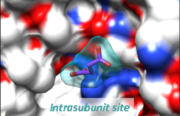Journal:Acta Cryst D:S205979832000772X
From Proteopedia
(Difference between revisions)

| Line 15: | Line 15: | ||
These extracellular sites are of great interest because they can accommodate drugs distinct from the common hydrophobic general anaesthetics that find their binding site through diffusion in the plasma membrane. Moreover, one of these sites, namely the intrasubunit one, is conserved in other cationic pLGICs such as the serotonin receptor, allowing a more specific targeting of cationic receptors. <scene name='85/853345/Cv/24'>Mapping the intrasubunit succinate binding-site to the X-ray structure of the 5HT3 serotonin receptor</scene> (PDB code [[4pir]]). See also the static image below: | These extracellular sites are of great interest because they can accommodate drugs distinct from the common hydrophobic general anaesthetics that find their binding site through diffusion in the plasma membrane. Moreover, one of these sites, namely the intrasubunit one, is conserved in other cationic pLGICs such as the serotonin receptor, allowing a more specific targeting of cationic receptors. <scene name='85/853345/Cv/24'>Mapping the intrasubunit succinate binding-site to the X-ray structure of the 5HT3 serotonin receptor</scene> (PDB code [[4pir]]). See also the static image below: | ||
| - | [[Image:Figel2.png|thumb|left|]] | + | [[Image:Figel2.png|thumb|left|Succinate is shown as purple sticks]] |
{{Clear}} | {{Clear}} | ||
This latter site is likely to be a key pharmacological site and thus an important target for rational drug design against some neurological disorders involving human pLGICs. | This latter site is likely to be a key pharmacological site and thus an important target for rational drug design against some neurological disorders involving human pLGICs. | ||
Revision as of 08:24, 7 July 2020
| |||||||||||
This page complements a publication in scientific journals and is one of the Proteopedia's Interactive 3D Complement pages. For aditional details please see I3DC.

